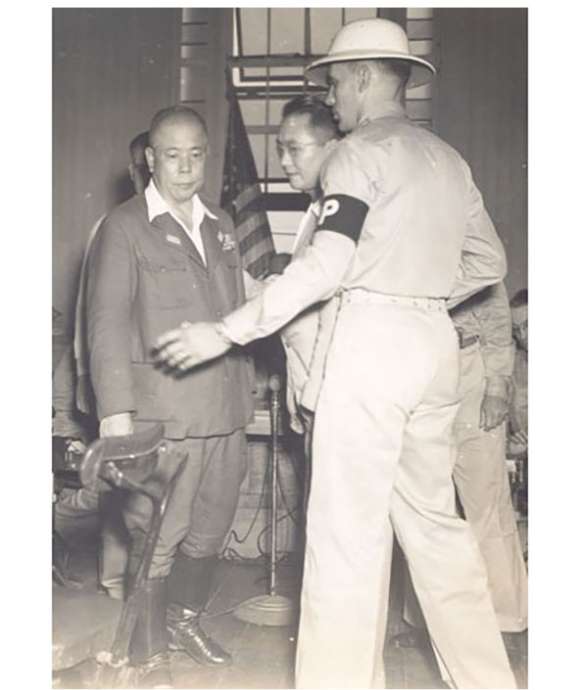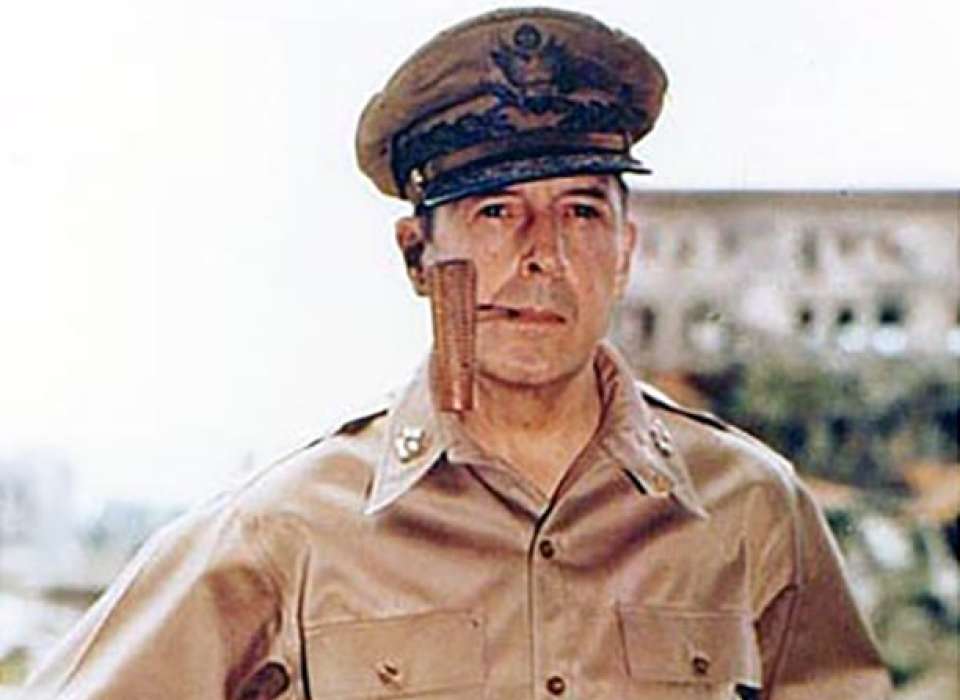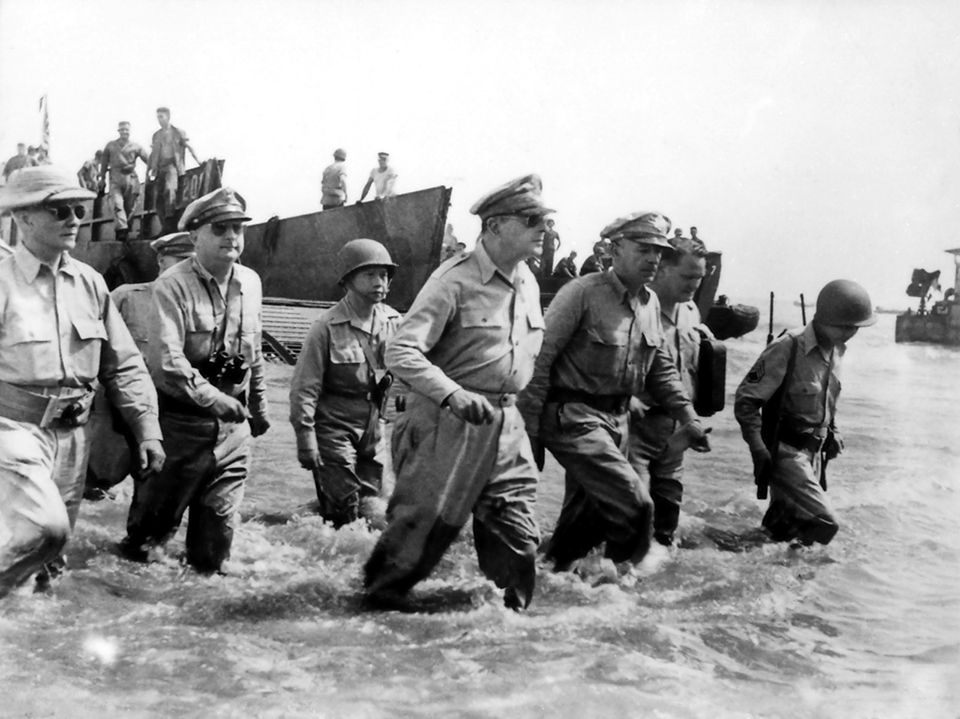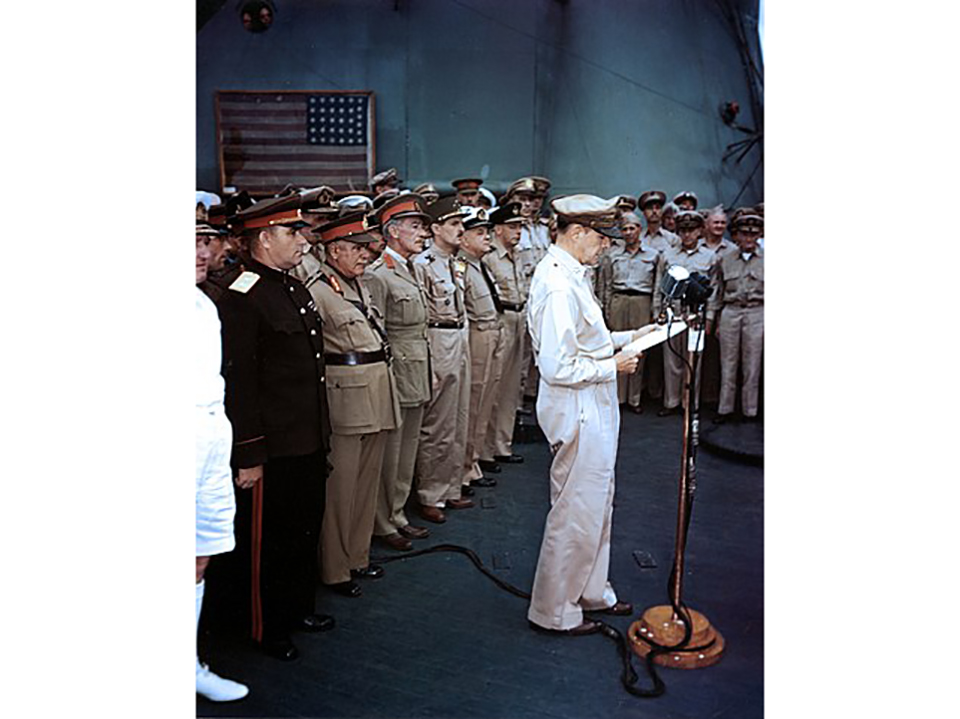Top Image: Gen. Douglas MacArthur, Manila, August 2, 1945. Courtesy of the US Naval Historical Center, USA C-2413.
On October 20, 1944, General Douglas MacArthur delivered his famous “I Have Returned” speech upon landing on Leyte Island. It is one of the most iconic phrases of the war, coupled with one of the most famous photographs, that captured the moment he waded ashore.
MacArthur landing at Leyte, October 20, 1944. Image by US Army Signal Corps officer Gaetano Faillace, courtesy of the National Archives and Records Administration, 531424.
A lesser known, but perhaps more monumental message came from MacArthur’s General Headquarters on July 5, 1945, when he declared all of the Philippines had been liberated. The Japanese conquest of the Philippines was one of the worst military disasters in American history. Recapturing the islands after more than three years under Japanese control, therefore, was one of the greatest symbolic and strategic victories of the Pacific war.
Some key points that stand out in the text of the official communique (shown below) are: MacArthur’s detailed list of the Japanese order of battle; his emphasis on the fact that Japanese forces held a numerical advantage in the Philippines; and the number of square miles and people that were liberated.
Curiously absent in MacArthur’s communique was any reference to his own order of battle or commanders’ names. Instead he refers simply to forces under his command. Nor did MacArthur mention progress in the Central Pacific campaign (a primarily Marine Corps and Navy effort), efforts on mainland Asia, or the combined air and naval blockade of the Japanese home islands, which assisted in preventing further reinforcements being sent to the Pacific islands. Though the American general did reference guerilla efforts in his communique, he mentioned resistance by the remaining Japanese forces in the Philippines, without giving credit to the brave efforts of the Filipinos and Americans who had harassed Japanese forces in occupied areas.
MacArthur’s communique’ is reprinted below in its entirety:
The entire Philippine Islands are now liberated and the Philippine Campaign can be regarded as virtually closed. Some minor isolated action of a guerrilla nature in the practically uninhabited mountain ranges may occasionally persist, but this great land mass of 115,600 square miles with a population of 17,000,000 is now freed of the invader.
The enemy during the operations employed twenty-three divisions, all of which were practically annihilated. Our forces comprised seventeen divisions. This was one of the rare instances when in a long campaign a ground force superior in numbers was entirely destroyed by a numerically inferior opponent. The Japanese ground forces comprised the following divisions or equivalents: 1st, 8th, 10th, 16th, 19th, 23rd, 26th, 30th, 100th, 102d, 103d, 105th, 2d Armored, 2d Airborne Brigade (reinforced to divisional strength), the 54th, 55th, 58th, 61st and 68th Independent Mixed Brigades (reinforced to divisional strength), three divisional units known as the Kobayashi, Suzuki and Shimbu commands, organized from twenty-eight independent battalions, three naval divisions comprising a Provisional Naval Command of corps strength, under Admirals Iwabuchi and Shiroya, and a large number of base and service elements. The total strength approximated 450,000 men.
Naval and air forces shared equally with the ground troops in accomplishing the success of the campaign. Naval battles reduced the Japanese Navy to practical impotence and the air losses, running into many thousands, have seriously crippled his air potential. Working in complete unison the three services inflicted the greatest disaster ever sustained by Japanese arms.
The objects of the campaign were as follows:
1. To penetrate and pierce the enemy's center so as to divide him into north and south, his homeland to the north, his captured Pacific possessions to the south. Each half could then be enveloped and attacked in turn.
2. The acquisition of a great land, sea and air base for future operations both to the north and to the south comparable to the British Islands in its use as a base for allied operations from the west against Germany.
3. The establishment of a great strangulating air and sea blockade between Japan and the conquered possessions in the Pacific to the south so as to prevent raw materials from being sent to the north and supply or reinforcement to the south.
4. The Liberation of the Philippines with the consequent collapse of the enemy's imperial concept of a Greater East Asia Co-Prosperity Sphere and the reintroduction of democracy in the Far East.
5. The liberation of our captured officers and men and of internees held in the Philippines.
6. A crippling blow to the Japanese Army, Navy, and Air force.
All of these purposes were accomplished.
Though victory came at a steep price, with more than 200,000 American and allied casualties during the 1941-1942 and 1944-1945 campaigns, this was a momentous occasion that saw MacArthur and his forces fulfill the promise made to their Filipino allies in the early dark days of the war. In the wake of this and other victories, all attention focused on the anticipated invasions of the Japanese home islands, which were expected to dwarf all previous battles involving US forces in the Pacific.
Of course, the invasions never took place as the Japanese announced their surrender on August 15 and then formally signed the surrender on board the USS Missouri on September 2, 1945, with the proceedings being overseen by General Douglas MacArthur.
MacArthur onboard the USS Missouri closing the surrender ceremony, September 2, 1945. Courtesy of the US Naval Historical Center, USA C-2717

Interview with James M. Scott, Author of Rampage: MacArthur, Yamashita, and the Battle of Manila
A discussion on the destruction of the Pearl of the Orient.
This article is part of an ongoing series commemorating the 75th anniversary of the end of World War II made possible by Bank of America.
Jeremy Collins
Jeremy Collins joined The National WWII Museum in 2001 as an intern, and now oversees the institution’s public programming initiatives.
Cite this article:
MLA Citation:
APA Citation:
Chicago Style Citation:










![Max Fuchs, New York City cantor, sings as Rabbi Sydney [sic] Lefkowitz, Richmond, VA, conducts the first Jewish services from Germany.](/sites/default/files/styles/max_650x650/public/2025-10/image1.jpg)

